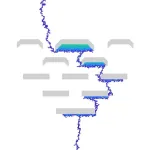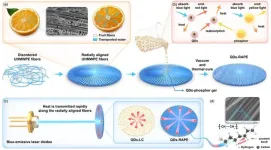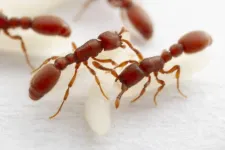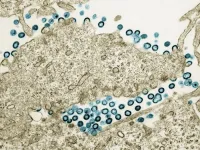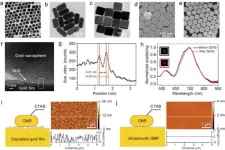(Press-News.org) Researchers working at the forefront of an emerging photovoltaic (PV) technology are thinking ahead about how to scale, deploy, and design future solar panels to be easily recyclable.
Solar panels made of perovskites may eventually play an important role amid global decarbonization efforts to reduce greenhouse gas emissions. As the technology emerges from the testing stages, it is a perfect time to think critically about how best to design the solar panels to minimize their impact on the environment decades from now.
“When you have a technology in its very early stages, you have the ability to design it better. It’s a cleaner slate,” said Joey Luther, a senior research fellow at the U.S. Department of Energy’s (DOE's) National Renewable Energy Laboratory (NREL) and coauthor of the newly published article in the journal Nature Materials. “Pushing perovskite PV toward enhanced sustainability makes more sense at this stage. We’re thinking about how we can make sure we have a sustainable product now rather than dealing with sustainability issues toward the end of its practical life.”
The PV research community, the article noted, is in an influential position to prioritize efforts in remanufacturing, recycling, (aka a “circular economy”) and reliability to make perovskite PV among the most sustainable energy sources on the market.
"Perovskites could unlock the next evolution of high-efficiency PV, and it is our responsibility to assure they are manufactured, used, and recycled sustainably," said the lead author of the study, Kevin Prince, a former graduate researcher at NREL who is now researching perovskites at Helmholtz Zentrum Berlin in Germany.
Solar panels made from silicon dominate the industry, and while they have enormous environmental and climate benefits, they were not initially designed for “circularity.” The other leading solar technology, cadmium telluride (CdTe), has had an established recycling program from the technology’s inception partly to address the scarcity of telluride. All forms of tech manufacturing come with environmental costs, such as recycling challenges and the use of potentially toxic chemicals. But perovskites are at an inflection point, so the opportunity exists to address those concerns now.
The most efficient circular economy begins at the design stage and considers materials sourcing, strategizes for a long product lifetime, and plans end-of-life management. According to the researchers, the most representative way to assess the environmental impacts of solar panel manufacturing is to look at carbon emissions released during production, embodied energy, sustainable material sourcing, and module circularity.
The journal article identifies critical sustainability concerns for each component of a perovskite solar panel. Lead, for example, could be diluted with other chemically similar metals, such as tin, to lessen the amount of lead in a future panel. However, to date, these substitutions have come at the cost of PV efficiency and durability, requiring much more research before these proposed semiconductors are ready to use in modules. The researchers also suggest that expensive precious metals used in perovskite research cells, including silver and gold, should be replaced with low-cost alternatives, such as aluminum, copper, or nickel, for commercial modules. They also said fluorine-tin oxide would be a more practical material for the cell’s front electrodes rather than the scarcer indium used in indium-tin oxide.
“We want to have the lowest amount of embodied energy in the fabrication,” Luther said. “We want to have the lowest amount of emissions in the fabrication. At this stage, now is the chance to look at those components. I don’t think we have to change anything. It’s more a matter of what decisions should be made, and these arguments should certainly be discussed.”
The authors highlighted different ways to think about the circularity of perovskite panels. Remanufacturing, for example, comes into play when an old module is disassembled with the goal of using certain parts to make a new module. Recycling, meanwhile, calls for the conversion of waste materials into raw materials that can then be refined and reused. One component that requires attention is the specialized glass that provides structural support for perovskite solar modules and offers protection from the elements while remaining very clear to allow in a maximal amount of sunlight. Establishing a recycling pathway for the glass will become more critical as PV deployment grows. Glass manufacturing as it stands today requires raw materials and is an energy-intensive process.
Silvana Ovaitt, a PV researcher and coauthor of the paper, said that as the electricity in the grid itself gets cleaner, the manufacturing of the panels will also be cleaner, further reducing emissions.
“Another concern is the transportation of the final modules and the raw glass because those are the heaviest items," Ovaitt said. "Local manufacturing will be a great way to reduce those carbon impacts.”
The researchers explain that increasing PV module durability, thereby increasing its useful lifetime, is a more effective approach to reducing the net energy, energy payback, and carbon emissions than designing for circularity alone. Even though a panel can be designed with the end in mind, a longer lifespan means it will not have to be recycled as often.
“Ultimately, we want to make them as durable as possible,” Luther said. “But we also want to consider the aspects of whenever that time does come. We want to be deliberate about how to take them apart and to reuse the critical components.”
The other coauthors, all from NREL, are Heather Mirletz, E. Ashley Gaulding, Lance Wheeler, Ross Kerner, Xiaopeng Zheng, Laura Schelhas, Paul Tracy, Colin Wolden, Joseph Berry, and Teresa Barnes.
The DOE Solar Energy Technologies Office funded the research.
NREL is the DOE's primary national laboratory for renewable energy and energy efficiency research and development. NREL is operated for DOE by the Alliance for Sustainable Energy LLC.
END
NREL researchers highlight opportunities for manufacturing perovskite solar panels with a long-term vision
2024-07-23
ELSE PRESS RELEASES FROM THIS DATE:
Top Medicare advantage plans less available in disadvantaged areas
2024-07-23
Looking for a Medicare Advantage plan with a five-star quality rating? You’re less likely to find one available to you if you live in a county with higher poverty and unemployment, finds a new study published in JAMA Network Open.
These geographic disparities may be contributing to unequal health outcomes and limiting federal funds from reaching the regions most in need, according to the researchers.
“What this means is that Medicare beneficiaries living in counties with greater social disadvantage ...
Better carbon storage better carbon storage with stacked geology with stacked geology
2024-07-23
The overarching goal of all carbon capture and storage projects is the same: Keep carbon dioxide (CO2) emissions out of the atmosphere by storing them in the subsurface for good.
One way to do that is to inject the CO2 into a reservoir space that’s covered with a big lid – an impermeable caprock that can keep the gas in place and stop any upward flow in its tracks. That’s the model that petroleum exploration has relied on for decades when searching for oil traps, and it works for both oil and CO2. But according to research led by The University of Texas at Austin’s Bureau of Economic Geology, subsurface ...
Sharp temperature reduction for quantum dots in polymer by highly efficient heat dissipation pathways
2024-07-23
A new publication from Opto-Electronic Advances; DOI 10.29026/oea.2024.240036 , discusses sharp temperature reduction for quantum dots in polymer by highly efficient heat dissipation pathways.
Quantum dots (QDs), a kind of luminescent nanocrystals featuring size-tunable emission spectra and superior color purity are widely applied in optoelectronic fields. However, these particles are facing luminous efficiency degradation due to their temperature-sensitive characteristic and the high temperature in optoelectronic ...
UAF researcher creates way to detect elusive volcanic vibrations
2024-07-23
A new automated system of monitoring and classifying persistent vibrations at active volcanoes can eliminate the hours of manual effort needed to document them.
Graduate student researcher Darren Tan at the University of Alaska Fairbanks Geophysical Institute led development of the system, which is based on machine learning. Machine learning is a branch of artificial intelligence focused on building systems that learn from data, identify patterns and make decisions with minimal human intervention.
Details about Tan’s automated ...
Lissajous pattern multi-pass cell: Enhancing high sensitivity and simultaneous dual-gas LITES sensing
2024-07-23
A new publication from Opto-Electronic Sciences; DOI 10.29026/oes.2024.240013 , discusses highly sensitive and real-simultaneous CH4/C2H2 dual-gas LITES sensor based on Lissajous pattern multi-pass cell.
Trace gases are atmospheric constituents with a volume fraction of less than 1%. Despite their low concentrations, nitrogen oxides, hydrocarbons, and sulfides in the atmosphere have a significant impact on the environment, closely related to phenomena such as acid rain, greenhouse effects, and ozone layer depletion. Therefore, race gas detection of is crucial for environmental ...
Asexual reproduction usually leads to a lack of genetic diversity. Not for these ants.
2024-07-23
Genetic diversity is essential to the survival of a species. It’s easy enough to maintain if a species reproduces sexually; an egg and a sperm combine genetic material from two creatures into one, forming a genomically robust offspring with two distinct versions of the species’ genome.
Without that combination of different genetic makeups, asexually reproducing species typically suffer from a lack of diversity that can doom them to a limited run on Earth. One such animal should be the clonal raider ant, which produces daughter after genetically identical daughter directly from an unfertilized ovum ...
Mini lungs make major COVID-19 discoveries possible
2024-07-23
Scientists at Sanford Burnham Prebys, University of California San Diego and their international collaborators have reported that more types of lung cells can be infected by SARS-CoV-2 than previously thought, including those without known viral receptors. The research team also reported for the first time that the lung is capable of independently mustering an inflammatory antiviral response without help from the immune system when exposed to SARS-CoV-2.
This work is especially timely, as cases of COVID-19 are on the rise in the scientists’ hometown of San Diego during a summertime spike. Looking beyond the region, more than half of the states in the country have reported “very ...
Exploratory analysis associates HIV drug abacavir with elevated cardiovascular disease risk in large global trial
2024-07-23
WHAT:
Current or previous use of the antiretroviral drug (ARV) abacavir was associated with an elevated risk of major adverse cardiovascular events (MACE) in people with HIV, according to an exploratory analysis from a large international clinical trial primarily funded by the National Institutes of Health (NIH). There was no elevated MACE risk for the other antiretroviral drugs included in the analysis. The findings will be presented at the 2024 International AIDS Conference (AIDS 2024) in Munich, Germany.
The Randomized Trial to Prevent Vascular Events in HIV (REPRIEVE) enrolled 7,769 study participants with HIV from 12 countries that found ...
Control of light–matter interactions in two-dimensional materials with nanoparticle-on-mirror structures
2024-07-23
A new publication from Opto-Electronic Sciences; DOI 10.29026/oes.2024.230051 , discusses control of light–matter interactions in two-dimensional materials with nanoparticle-on-mirror structures.
With the rapid development of high bit-rate wireless services driven by mobile internet, AI computing, high-definition videos, virtual reality/augmented reality (VAR) applications, and so on, the demand for wireless data rates has grown explosively in the past decades1, 2. Supporting such fast data rate at tens of Gbit/s pushes the carrier frequency to the THz (0.1-10 THz) ...
Does the onset of daylight saving time lead to an unhealthy lifestyle?
2024-07-23
Researchers from North Carolina State University, University of Manitoba, Bern University of Applied Sciences, University of South Carolina, and California Baptist University published a new Journal of Marketing study that explores whether the onset of daylight saving time leads consumers to engage in unhealthy behaviors.
The study, forthcoming in the Journal of Marketing, is titled “Spring Forward = Fall Back? The Effect of Daylight Saving Time Change on Consumers’ Unhealthy Behavior” and is authored by Ramkumar Janakiraman, Harsha ...
